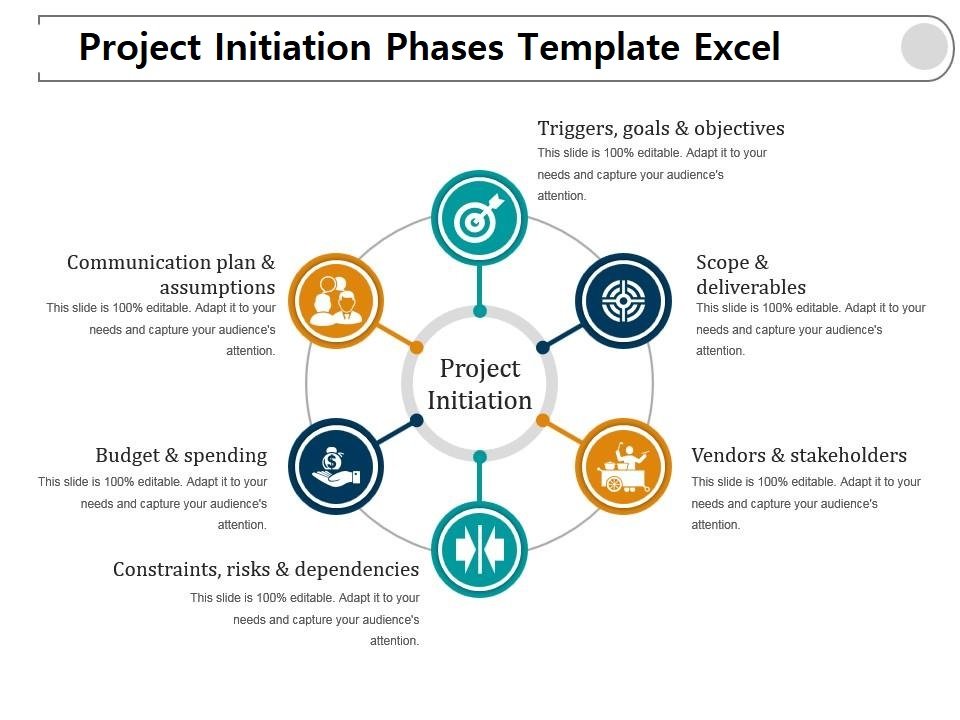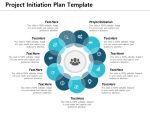Looking for Initiation phase templates in the printable format of Word, and PDF? A Project Initiation Plan (PIP) serves as a foundation document outlining key project aspects. It covers
- Project objectives
- Scope
- Stakeholders
- Resources
- Timeline
- And initial risks
The PIP has a clear understanding among team members and stakeholders about the project’s direction. It outlines the project’s purpose, goals, and expected outcomes, providing a roadmap for the team to follow.
Check out Project Management Transition Plan Template as a related template.
Project Initiation Phase Roadmap Template
Additionally, it identifies stakeholders and defines their roles, responsibilities, and communication channels. The PIP also highlights available resources and establishes a high-level timeline, setting the project’s initial boundaries.
Initial risks and mitigation strategies are outlined to proactively address potential challenges. Overall, it acts as a crucial reference point, aligning all parties and facilitating a smooth project kickoff.
Related Template: Project Costing Template Excel

Elements of project Initiation plan template
A Project Initiation Plan (PIP) comprises vital elements
Project Overview– Clearly defines project goals, objectives, and scope to establish a common understanding.
Stakeholder Analysis – Identifies and assesses key stakeholders, determining their roles, interests, and communication needs.
Roles and Responsibilities – Outlines project team members’ duties, authority, and reporting structures to maintain a structured workflow.
Resource Allocation -Specifies require personnel, budget, equipment, and facilities for seamless execution.
Preliminary Schedule – Sets initial milestones and timelines, aiding project monitoring and progress tracking.
Risk Identification – Identifies potential challenges, uncertainties, and risks, laying the foundation for proactive risk management.
Risk Mitigation Strategies –Establishes plans to address identified risks, and timely and effective responses.
Compliance Considerations – Addresses legal, regulatory, and ethical requirements to project adherence.
Communication Plan – Outlines how information is shared among team members and stakeholders, fostering transparency.
Approvals and Sign-offs –Defines processes for obtaining necessary approvals and sign-offs, formal commitment.
Budget Overview – Provides an initial financial overview, ensuring alignment with allocated funds.
Project Documentation –Specifies the types of documentation to produce and maintain throughout the project.
These features collectively create a comprehensive PIP, guiding the project initiation plan, minimizing uncertainties, and setting the stage for a successful project journey.
You can download Project Plan Template with Dependencies
5-phases of project planning Must Notice before Staring Project
These phases collectively that projects begin with a clear understanding of their purpose, feasibility, and expected outcomes. By addressing potential challenges early and involving key stakeholders, project initiation sets the stage for effective project execution and successful delivery.
Project Initiation
Project initiation is the foundational phase where a project’s feasibility, objectives, and scope are determined.
- It includes idea generation, feasibility analysis, and the creation of a project charter.
- Stakeholders are identified, their interests consider, and a clear communication plan establish.
- This phase prepares for the project execution, where key roles and responsibilities are assigned, and initial timelines are set.
- Project initiation shared understanding among stakeholders mitigates risks early on and provides a framework for the project’s successful execution.
|
Project Initiation |
Broadly define your project and secure buy-in. |
|
Project Planning |
Create detailed goals and a project roadmap. |
|
Project Execution |
Launch your project using information from the first two steps. |
|
Project Performance |
Measure effectiveness using key performance indicators (KPIs). |
Related Article: Project Documentation Template Word
Project Planning
Project planning is the phase where the project’s objectives, scope, and detailed tasks are defined.
- It is creating a comprehensive project plan that outlines timelines, resource allocation, and risk management strategies.
- Key milestones, deliverables, and dependencies are identified, providing a roadmap for the project team.
- Budgets and schedules are final, and communication channels establish.
- The project plan serves as a guide for execution, aiding in resource coordination, progress tracking, and risk mitigation.
- Thorough planning efficient resource utilizes, minimizes scope changes, and enhances the project’s overall success by providing an approach to achieving the desired outcomes.
Project Execution
Project execution is the phase where the planned tasks are carried out to achieve project objectives.
- Teams execute the project implementation plan, allocate resources, and manage tasks according to the schedule.
- Communication and collaboration among team members and stakeholders play a crucial role.
- Progress is monitored, and any necessary adjustments are made to ensure goals.
- This phase demands effective leadership, coordination, and problem-solving as challenges arise.
- Successful execution relies on adherence to the project plan, efficient resource management, and proactive issue resolution.
- Ultimately, project execution transforms plans into tangible outcomes, fostering the project’s advancement toward successful completion.
Project Performance and Monitoring
- Project performance and monitoring continuous assessment of project activities against established benchmarks.
- Key performance indicators (KPIs) are tracking to measure progress, quality, and adherence to schedules and budgets.
- Regular status updates and reports keep stakeholders informed.
- Deviations from the plan are identified, and corrective actions are taken to address challenges promptly.
- Effective monitoring ensures that the project stays on track, resources are optimally used, and risks are managed.
- Adjustments are based on real-time data, improving decision-making.
This phase promotes transparency, accountability, and proactive problem-solving, contributing to the project’s overall success.
Project Close
Project closure is the final phase where a project is formally concluded. It includes all project tasks and deliverables that are complete as per the plan.
- Final documentation, reports, and lessons learned are compiled.
- Stakeholders are informed about the project’s conclusion, and final approvals or sign-offs are obtained.
- The remaining resources are closed off, and contracts are final.
- A post-project review is conducted to evaluate the project’s success and identify areas for improvement.
- Project closure is essential for a seamless transition to operations or the next project.
- It signifies the end of active project work and allows organizations to celebrate achievements, analyze shortcomings, and capture insights for future endeavors.
How to Manage Project Initiation Documents?
Project initiation documents, such as a Project Charter or Project Initiation Plan (PIP), outline a project’s purpose, objectives, scope, and initial plan.
They identify stakeholders, roles, responsibilities, and resources needed.
These documents set the stage for project execution by defining the project’s boundaries, goals, and initial strategies, ensuring a shared understanding among team members and stakeholders.
Check out Project Risk Mitigation Plan Template Excel as a related template.
Project goals
Project goals are the specific and measurable outcomes that a project aims to achieve.
- They provide a clear direction and purpose for the project, guiding the team’s efforts.
- Well-define goals help prioritize tasks, allocate resources, and measure success.
- Goals should be realistic, achievable, and aligned with the project’s overall objectives.
- They serve as a focal point for decision-making throughout the project lifecycle, ensuring that all activities contribute to the desired end results.
Scope Initiation phase
- Project scope refers to the boundaries and extent of work that a project encompass.
-
It defines the specific deliverables, features, functions, and requirements that the project includes.
- The scope outlines what is within the project’s scope and what is not, helping to establish clear expectations and prevent scope creep.
- A well-defined project scope ensures that everyone understands the project’s limits.
The project remains manageable, on track, and aligns with its objectives.
Project organization Phase
- Project organization in project initiation refers to structuring the team and roles in the project.
- This is identifying key stakeholders, determining team members’ roles and responsibilities, and establishing reporting hierarchies.
- Clear project organization ensures efficient communication, coordination, and decision-making.
- It clarifies who is accountable for various tasks and helps prevent confusion during project execution.
- Proper project organization sets the stage for effective collaboration and lays the groundwork for a successful project outcome.

Business Case Initiation Phase Template
- A business case in a project initiation plan outlines the justification for the project.
- It provides a comprehensive analysis of the project’s expected benefits, costs, risks, and feasibility.
- The business case helps stakeholders understand why the project is necessary, what problems it aims to solve, and how it aligns with the organization’s strategic goals.
- It includes financial projections, potential return on investment, and a comparison of various options.
- The business case serves as a crucial document for decision-makers, guiding them in approving or declining the project based on its potential value and alignment with the organization’s priorities.
Constraints
- Constraints in an initiation plan refer to the limitations and boundaries that impact the project’s execution.
- These include budget restrictions, resource availability, time constraints, regulatory requirements, and technological limitations.
- Identifying constraints in the early stages of project initiation helps set realistic expectations and guides the project’s scope and objectives.
- Mitigation strategies are devised to address or work around these constraints to ensure successful project completion.
Stakeholders Initiation Phase Template
Stakeholders in a project initiation plan are individuals, groups, or entities that have a vested interest in the project’s outcomes. They are including project sponsors, team members, customers, users, regulators, and more.
- Identifying stakeholders is crucial during project initiation to understand their expectations, needs, and influence levels.
- Effective stakeholder analysis ensures proper engagement, and communication strategies.
- As well as alignment with their requirements, contributing to successful project planning and execution.
Related Template: Project Execution Plan Template Excel
Risks Initiation Phase Template
Risks in a project initiation plan refer to potential uncertainties or challenges that could impact the project’s success.
- Identifying and assessing risks at the outset allows for early planning and mitigation strategies.
- Addressing risks in the initiation phase enhances decision-making and minimizes the impact of unforeseen issues during project execution.
Project controls Initiation Phase Template
Project controls in a project initiation plan encompass the processes, tools, and methods used to manage and monitor various aspects of the project.
- These include cost management, schedule management, quality assurance, and risk management.
Establishing project controls in the initiation phase template ensures an approach to tracking and adjusting project performance, leading to efficient execution and successful project outcomes.

